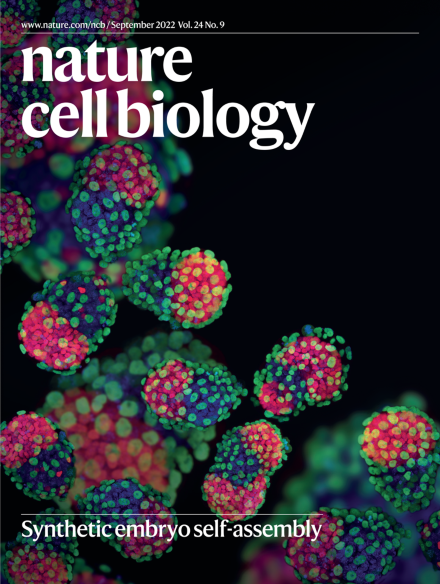相分离的NDF-FACT凝聚物促进染色质上的转录延伸。
IF 19.1
1区 生物学
Q1 CELL BIOLOGY
引用次数: 0
摘要
促进染色质转录(FACT)复合物如何使RNA聚合酶II克服细胞中的染色质屏障仍然知之甚少-特别是考虑到FACT与聚合酶,DNA或核小体的直接相互作用有限。在这里,我们证明了核小体不稳定因子(NDF)介导的相分离是使FACT在转录延伸过程中发挥作用的关键机制。通过生化和单分子分析,我们发现NDF-FACT凝聚物创造了专门的生化环境,与FACT单独相比,其转录效率提高了约20倍。这些动态凝聚物在转录RNA聚合酶II上形成并沿着染色质移动,在那里它们促进屏障处核小体的有效分解,同时保留DNA上的组蛋白以保持染色质的完整性。在人类干细胞中,这些凝聚体的破坏导致全基因组转录缺陷和染色质不稳定,反映了FACT耗竭的影响。通过显示相分离在转录延伸过程中增强FACT功能,我们的研究揭示了在人类干细胞中保持染色质完整性和转录稳态的关键机制。本文章由计算机程序翻译,如有差异,请以英文原文为准。
Phase-separated NDF-FACT condensates facilitate transcription elongation on chromatin.
How the facilitates chromatin transcription (FACT) complex enables RNA polymerase II to overcome chromatin barriers in cells remains poorly understood-especially given the limited direct interactions of FACT with polymerases, DNA or nucleosomes. Here we demonstrate that phase separation, mediated by nucleosome destabilizing factor (NDF), is a key mechanism enabling the function of FACT during transcription elongation. Through biochemical and single-molecule assays, we found that NDF-FACT condensates create specialized biochemical environments that enhance transcription efficiency approximately 20-fold compared with FACT alone. These dynamic condensates form on transcribing RNA polymerase II and travel along chromatin, where they promote efficient nucleosome disassembly at barriers while retaining histones on DNA to preserve chromatin integrity. In human stem cells, disruption of these condensates leads to genome-wide transcriptional defects and chromatin instability, mirroring the effects of FACT depletion. By showing that phase separation enhances FACT function during transcription elongation, our study reveals a key mechanism that preserves chromatin integrity and transcriptional homeostasis in human stem cells.
求助全文
通过发布文献求助,成功后即可免费获取论文全文。
去求助
来源期刊

Nature Cell Biology
生物-细胞生物学
CiteScore
28.40
自引率
0.90%
发文量
219
审稿时长
3 months
期刊介绍:
Nature Cell Biology, a prestigious journal, upholds a commitment to publishing papers of the highest quality across all areas of cell biology, with a particular focus on elucidating mechanisms underlying fundamental cell biological processes. The journal's broad scope encompasses various areas of interest, including but not limited to:
-Autophagy
-Cancer biology
-Cell adhesion and migration
-Cell cycle and growth
-Cell death
-Chromatin and epigenetics
-Cytoskeletal dynamics
-Developmental biology
-DNA replication and repair
-Mechanisms of human disease
-Mechanobiology
-Membrane traffic and dynamics
-Metabolism
-Nuclear organization and dynamics
-Organelle biology
-Proteolysis and quality control
-RNA biology
-Signal transduction
-Stem cell biology
 求助内容:
求助内容: 应助结果提醒方式:
应助结果提醒方式:


